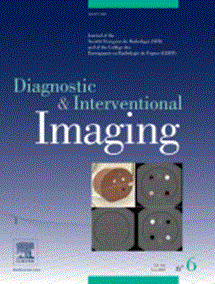前列腺实时多层磁共振测温:可行性、准确性和患者偏倚来源的评估。
IF 8.1
2区 医学
Q1 RADIOLOGY, NUCLEAR MEDICINE & MEDICAL IMAGING
引用次数: 0
摘要
目的:本研究的主要目的是评估核磁共振测温序列监测前列腺温度的准确性。次要目的是分析可能影响准确性的临床和技术因素,并在现实环境中对离体肌肉样本进行核磁共振引导激光消融测试。材料和方法:利用二维多层分割回波平面成像序列对离体肌肉样本进行激光消融,进行磁共振测温。将磁共振测温测量结果与侵入式传感器温度读数进行比较,以评估准确性。随后,56名中位年龄为70岁(年龄范围:53-84岁)的男性在1.5 T (n = 27)或3 T (n = 24)时接受了前列腺MRI检查。对于每个患者,计算前列腺中“噪声体素”(即温度[SD(T)]的时间标准偏差[SD(T)] >2°C)的比例。临床和技术因素对噪声体素比例的影响也进行了研究。结果:核磁共振温度测量与有创传感器在核磁共振引导下对离体肌肉样本进行激光消融时表现出良好的相关性。在整个队列中,每个患者的噪声体素的中位数比例为1% (Q1, 0.2;第三,4.9;范围:0 - 90.4)。在1.5 T和3 T时进行的检查中,噪声体素的中位数比例无显著差异(调整前后P = 0.89)。没有临床或技术因素显著影响噪声体素的比例。结论:二维实时多层磁共振测温法监测前列腺温度是可行且准确的。本文章由计算机程序翻译,如有差异,请以英文原文为准。
Real-time multislice MR-thermometry of the prostate: Assessment of feasibility, accuracy and sources of biases in patients
Purpose
The primary purpose of this study was to evaluate the accuracy of an MR-thermometry sequence for monitoring prostate temperature. The secondary purposes were to analyze clinical and technical factors that may affect accuracy and testing the method in a realistic setting, with MR-guided Laser ablation on an ex vivo muscle sample.
Materials and methods
An ex vivo muscle sample was subjected to Laser ablation while using a two-dimensional multislice segmented echo planar imaging sequence for MR thermometry. The MR thermometry measurements were compared with invasive sensor temperature readings to assess accuracy. Subsequently, 56 men with a median age of 70 years (age range: 53–84 years) who underwent prostate MRI examinations at 1.5- (n = 27) or 3 T (n = 24) were prospectively included. For each patient, the proportion of 'noisy voxels' (i.e., those with a temporal standard deviation of temperature [SD(T)] > 2 °C) in the prostate was calculated. The impact of clinical and technical factors on the proportion of noisy voxels was also examined.
Results
MR-thermometry showed excellent correlation with invasive sensors during MR-guided Laser ablation on the ex vivo muscle sample. The median proportion of noisy voxels per patient in the entire cohort was 1 % (Q1, 0.2; Q3, 4.9; range: 0–90.4). No significant differences in median proportion of noisy voxels were observed between examinations performed at 1.5 T and those at 3 T (P = 0.89 before and after adjustment). No clinical or technical factors significantly influenced the proportion of noisy voxels.
Conclusion
Two-dimensional real time multislice MR-thermometry is feasible and accurate for monitoring prostate temperature in patients.
求助全文
通过发布文献求助,成功后即可免费获取论文全文。
去求助
来源期刊

Diagnostic and Interventional Imaging
Medicine-Radiology, Nuclear Medicine and Imaging
CiteScore
8.50
自引率
29.10%
发文量
126
审稿时长
11 days
期刊介绍:
Diagnostic and Interventional Imaging accepts publications originating from any part of the world based only on their scientific merit. The Journal focuses on illustrated articles with great iconographic topics and aims at aiding sharpening clinical decision-making skills as well as following high research topics. All articles are published in English.
Diagnostic and Interventional Imaging publishes editorials, technical notes, letters, original and review articles on abdominal, breast, cancer, cardiac, emergency, forensic medicine, head and neck, musculoskeletal, gastrointestinal, genitourinary, interventional, obstetric, pediatric, thoracic and vascular imaging, neuroradiology, nuclear medicine, as well as contrast material, computer developments, health policies and practice, and medical physics relevant to imaging.
 求助内容:
求助内容: 应助结果提醒方式:
应助结果提醒方式:


